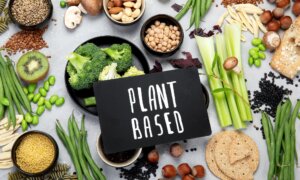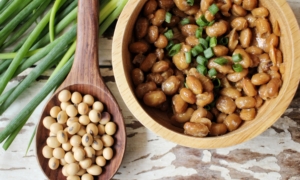Health Viewpoints
The number one objection I hear to adopting a diet of real food is, “I can’t afford it!” I know that it is very hard to nourish yourself and your family on a budget these days. Yet, some processed foods are very expensive, while the unprocessed alternatives cost no more—and maybe even less—and can make a huge difference in your health and that of your family.
Here are some examples of healthy alternatives to processed foods:
1. Salad Dressing
The typical bottled salad dressing costs about twenty-five cents per fluid ounce. I have always recommended making your own salad dressing with good-quality olive oil as
the number one step you can take to improving your health. But won’t that cost more, especially as the price of olive oil is climbing? Not if you choose your olive oil carefully. Kirkland olive oil from Costco, for example, comes in at about thirty-two cents per ounce.
If your olive oil and vinegar dressing is 75 percent olive oil, the cost of your olive oil will be 24 cents per ounce, slightly less than the cost of the typical bottled dressing. The cost of your added ingredients—vinegar, mustard, seasonings—is minimal. Making your own dressing will cost only a little bit more than purchasing bottled dressing, but the savings gained in health benefits more than make up the difference.
Bottled dressings are made with the cheapest industrial seed oils—oils you do not want to put into your body or those of your children—plus a host of hard-to-digest additives. It takes only a few minutes to make salad dressing with healthy ingredients and for only pennies more.

A simple dressing of olive oil and vinegar is both good for your health and easy on your pocketbook. (Elena Veselova/Shutterstock)
2. Breakfast Cereal
Nothing gives less value for money than dry breakfast cereal. Typical breakfast cereals, such as Corn Flakes, Cheerios, Grape Nuts, or Wheaties, cost about five dollars or more per box and contain twelve one-cup servings. That’s about 42 cents per serving—if you can limit yourself to one serving.
Dry organic oatmeal costs as little as eight cents per ounce. Twelve cents worth of dry oat flakes cooks up into a one-cup serving of oatmeal, which definitely leaves you feeling full. If you put 1 tablespoon of butter on your oatmeal (rather than half a cup of skim milk as recommended by the Diet Dictocrats) you are still ahead.
Even if you add a natural sweetener or some raisins, your oatmeal breakfast will cost less than one based on dry cereal—and will be way more nutritious, especially if you soak your oatmeal overnight to neutralize anti-nutrients and release minerals.

Oatmeal is a wholesome, affordable alternative to boxed cereal. (Shutterstock)
3. Butter
Good quality butter costs more than margarines and spreads, for sure—but not much more. A two-pound box of Kirkland grass-fed butter comes in at thirty-four cents per ounce. Conventional butter can be had for about twenty-eight cents per ounce, right in there with vegetable oil spreads, which range from twenty to thirty cents per ounce.
Margarine costs about the same as spreads—although Earth Balance margarine costs thirty-seven cents per ounce, more than the grass-fed butter! And while we are talking about fats, why not cook in lard? Toxic, highly processed vegetable oil for cooking costs about seventeen cents per ounce. Very few supermarkets carry lard anymore, but you can purchase a quart of this stable, healthy fat at a farmers’ market for five dollars, which comes out to sixteen cents per ounce—less than the vegetable oil!
4. Eggs and Animal Foods
The price of eggs has gone up, but then so has the price of everything else. Today a dozen eggs cost around three dollars. Since the average egg weighs two ounces, that calculates to thirteen cents per ounce, making eggs the biggest bargain for high-quality protein food. Ground beef comes in at thirty-one cents per ounce and steak averages almost seventy cents per ounce.
If you like liver, avail yourself of calves’ liver in the supermarket. Calves in this country spend the first part of their lives on the open range, so the quality and nutrient levels will be high. The cost is around twenty-three cents per ounce, lower than ground beef and ten to one hundred times richer in vitamins and minerals. If you are on a budget, you can get the same nutrition by eating calves’ liver once a week as eating beef with every meal.

Eggs are a perfect package of high-quality, inexpensive protein. (Patrycja St/Shutterstock)
5. Snacks
Junk snacks range from nineteen cents per ounce (GoTo SqueeZ fruit pouches, basically pure sugar) to seventy-two cents per ounce (Pringles potato chips), with an average price in the forty-cents range (Goldfish, Cheezits, Rice Crispy Marshmallow Bars, for example). Many of these are high in sugar and bound to lead to the crankies—they also contain industrial seed oils, the fast track to health problems.
If you need a between-meal snack, what’s wrong with cheese? The average price of cheddar cheese today is thirty-four cents per ounce—less than the junk snacks. Cheese is nutritious and fills you up fast! Get cheese from pasture-fed cows if you can, but any cheese is better than junk snacks.
6. The Whole Chicken
One of my budget hacks is to buy a whole chicken. Skinless chicken breasts cost twenty-five cents per ounce, and they are dry and boring. A whole chicken comes in at thirteen cents per ounce (a bargain on par with eggs) and can be parlayed into many delicious meals. Bake the whole chicken for Sunday dinner along with a pot of brown rice, and make gravy with the drippings.
For two people, and even for four people, there will be leftovers, and the possibilities are endless—chicken hash made with chopped meat, rice, and leftover gravy, chicken curry, chicken enchiladas, chicken tacos, and chicken salad. Save all the bones and make chicken broth, which can be turned into a delicious soup. One whole chicken yields two or three other meals, for real savings.

Roasted chicken is an easy-to-prepare, inexpensive meal with leftovers that can stretch to several more dishes. (Sergii Koval/Shutterstock)
Weighing the Costs
Not only will you save money purchasing better quality, “healthy” food, but you will also save money on what you don’t buy—chips, cookies, pastries, and sodas. For a healthy soda, try adding a squeeze of lemon and a pinch of salt to sparkling water.
It’s also highly likely that you will save money on health care. In 1960, Americans spent 17 percent of their income on food. Today, we spend a mere 11.3 percent of our income on food, Meanwhile, health care costs have soared. And with rising health care costs come other costs in the form of having lower energy, more worry, and more stress.
When people say to me, “I can’t afford to eat healthy,” my reply is, “I can’t afford not to.”















